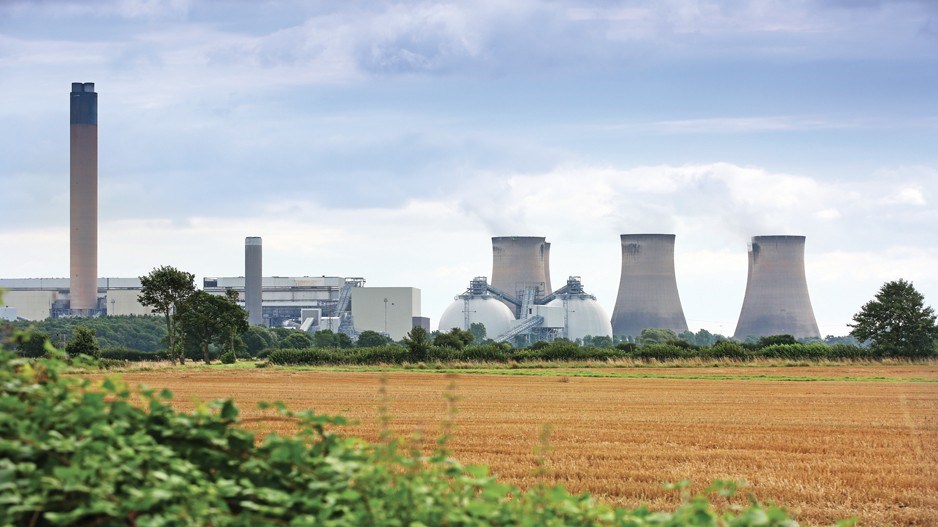A British power company that has cut its greenhouse gas emissions by 90% since 2012, largely by switching from coal to wood pellets at its thermal power plant in the U.K., has pledged to be carbon negative by 2030, and B.C.’s wood waste will play an important role in that effort.
Drax Group PLC (LON:DRX) aims to be the first major European power producer to combine biomass power generation with carbon capture and storage (CCS), which would result in negative emissions, to the tune of eight million tonnes annually.
The company’s plan to add CCS hinges on government support in the U.K. and a secure wood pellet supply, which is why it acquired B.C.’s largest wood pellet producer, Pinnacle Renewable Energy Inc. (TSX:PL), in April.
Pinnacle operates eight wood pellet plants in Western Canada and one in Alabama.
For a company that was once Western Europe’s largest coal power producer, Drax has pivoted dramatically over the last decade. This year, it ended its use of coal in its U.K. power plant and has sold all of its natural gas assets to become a pure-play renewable power producer. It provides the U.K. with 12% of its renewable power.
And as early as 2027, the company plans to outfit its thermal power station in North Yorkshire with a carbon capture and storage (CCS) unit. The company aims to add a second CCS unit by 2030. At that point, the power it produced would be considered carbon negative.
The Coalition for Negative Emissions estimates that one gigatonne of negative emissions will be needed by 2025 to keep global warming within 1.5 degrees.
Some environmentalists are squeamish about bioenergy and carbon capture, even though the Intergovernmental Panel on Climate Change (IPCC) recommends both in its pathways to decarbonization assessment. Some environmentalists view CCS as sweeping CO2 under the carpet and object to bioenergy if live trees are cut to feed wood pellet plants.
But intermittent wind and solar energy has proven unable to provide the amount of firm power modern industrial societies need. So for countries that don’t have sufficient hydro power, the next best options are either nuclear or biomass power.
While burning wood or other organic waste to produce power creates CO2, sustainable energy experts consider it to be carbon neutral, if done sustainably, because the CO2 emitted during combustion is eventually soaked up again when trees regrow.
Mark Jaccard, energy economist at Simon Fraser University, describes what Drax is planning to do on negative emissions as “wonderful,” and added that he hopes to see similar conversions of coal power plants in Alberta and Saskatchewan.
But Chris Bataille, adjunct professor at SFU’s School of Resource and Environmental Management and co-author of the Deep Decarbonization Pathways Project for Canada, said “the net neutrality of bioenergy is highly feedstock and case dependent.”
He said the problem with harvesting live trees for bioenergy – especially older ones — is the carbon debt: the time it takes for a tree to regrow and sequester all the CO2 that was released through combustion. If only wood waste is used, that debt is less, which increases when live trees are harvested, and increases even more with older trees.
The question of how much wood waste versus how many whole, live trees are used in wood pellet production is something producers and the provincial government will need to grapple with and explain to the public because B.C.’s wood pellet industry has been growing by leaps and bounds.
Canada is now the world’s second-largest wood pellet producer, and B.C. is Canada’s largest producer. Environmental groups have raised concerns that whole, live trees are being harvested in increasing volumes in B.C. to feed wood pellet plants.
Bioenergy researcher Jack Saddler, a professor at the University of British Columbia’s Department of Wood Science, said recent wildfires in B.C. have underscored the need not only to address climate change, but also the need to remove “fuel” – dead wood and debris – from forests. If that wood debris were to end up as wood pellets, it strengthens the case for biomass energy.
“If it’s done the right way, it’s good,” Saddler said. “But it can be done the wrong way. If you look at, say, taking a nice log that you could make a nice house out of, and then using that for energy, I don’t think that’s the best use for that log.”
One advantage of biomass over intermittent wind and solar is that it produces firm, dispatchable power. Another advantage is the jobs it creates.
“One of the big benefits with bioenergy, as compared to solar and wind, is it generates jobs,” Saddler said. “A lot of these jobs are in the rural communities; if it wasn’t for the pellet market, there wouldn’t be any jobs there.”




